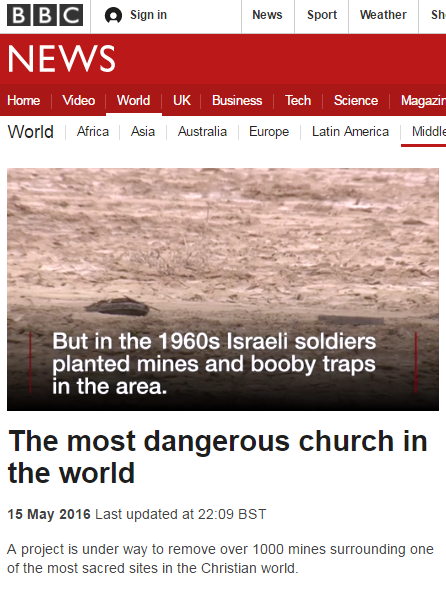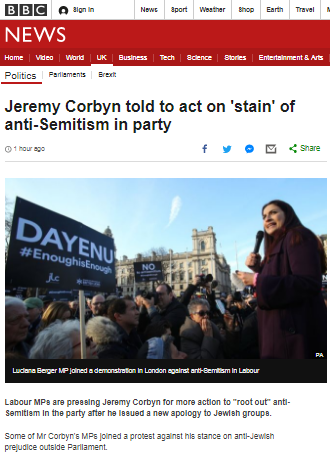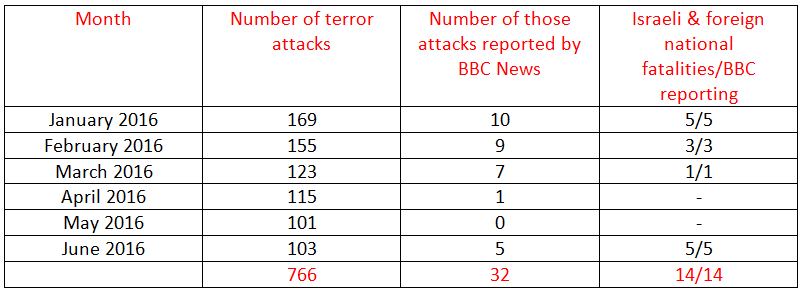h/t MD
On May 15th and 16th two reports – one filmed and one written – relating to the same story were published on the BBC News website.
The filmed report comes under the sensationalist title “The most dangerous church in the world“. If BBC audiences had until now perhaps thought that the most dangerous places in the world for Christians might be in Iraq or Syria, this report tells them that:
“This is one of the most sacred sites in the Christian world…and the most dangerous.”
Of course visitors to Qasr al Yahud in the Jordan Rift Valley who heed the fencing and signs warning them of landmines in the vicinity of the nearby derelict monasteries are in no danger whatsoever.
The report continues:
“It’s thought Jesus was baptized here at Qasr el Yahud. More than 300,000 pilgrims travel here each year. A few hundred meters away stand these abandoned churches. They were built over 1,000 years ago.”
Whilst the monastery of St John the Baptist was indeed first constructed in the Byzantine era and the current structure has foundations said to date back to the 12th century, most of the monasteries at the site were constructed in the 1930s during the time of the British Mandate.
Viewers are then told:
“But in the 1960s Israeli soldiers planted mines and booby traps in the area. The churches have been left empty ever since.”
In contrast with reports on the same story from other media organisations, no effort is made by the BBC to provide audiences with the relevant context which would enable their understanding of the background to that statement and prevent any misunderstanding of the reasons behind Israel’s mining of the area.
The Telegraph, for example, tells its readers that:
“Israeli forces laid around 2,600 anti-tank mines in long strings to prevent Jordanian armored units from crossing the River Jordan. The area is also scattered with more than a thousand anti-personnel mines which are not much bigger than an apple but can easily blow off a person’s legs.
To stop Palestinian fighters from hiding in the churches, Israeli soldiers built their own improvised explosive devices (IEDs) and rigged the buildings. No one knows how many of the bombs are still active. Added to the mix are mortar shells, artillery rounds and other unexploded ordinance still lying around from the [1967] fighting.”
The Times of Israel writes:
“Qasr al-Yehud, the site where many Christian traditions believe Jesus was baptized by John the Baptist, will soon be cleared of some 4,000 landmines and other ordnance left over from the 1967 war and its aftermath. […]
Israel mined the area along the Jordan River following the Six Day War in a bid to prevent Jordanian tanks and infantry, as well as Palestinian fedayeen guerrilla fighters and terrorists, from infiltrating into Israeli-held territory and attacking Israeli settlements.”
And the Wall Street Journal reports:
“After that conflict [1967], Israeli officials say military documents show that the army placed antitank mines on flat ground to deter armored vehicles from crossing the Jordan River.
Following skirmishes between Palestine Liberation Organization operatives and the Jordanian army and Israeli soldiers post-1967, Israel also placed antipersonnel mines on the site and booby-traps in the buildings to ensure they couldn’t be used as staging areas for attacks on Israel and Israeli settlements in the West Bank. The area became a buffer zone in fighting between Israeli and Palestinian and Jordanian operatives, said Michael Heiman, technology and standards manager at the Israel National Mine Action Authority which is part of the defense ministry.”
Viewers of this report were also told that:
“The plan is for it to become a national park with free access to all religions.”
Qasr al Yahud is in fact already a national park which has – literally – “free access” for all.
So did the BBC’s religious affairs correspondent Caroline Wyatt do any better in her written report (titled “New hope for Holy Land’s minefield churches“) on the same story? Not really.
In addition to misrepresenting the majority of the structures as having been built considerably earlier than is the case, Wyatt also failed to provide adequate explanation of why the area was mined after (rather than “during”, as stated) the Six Day War.
“For almost 50 years, the churches – built in Byzantine times but later booby-trapped, mined and pockmarked by artillery fire – have been crumbling gently in the middle of a minefield.
It was laid mainly by Israeli troops during the 1967 War, when Israel captured the land west of the River Jordan, known today as the occupied West Bank.”
As is overwhelmingly the case in BBC content, Wyatt’s history begins in June 1967 and so BBC audiences hear nothing of the 19 year-long Jordanian occupation of the area concerned or what preceded it. They are, however, encouraged to believe that the correct terminology for that part of Area C (the future of which is to be determined in final status negotiations according to the Oslo Accords signed by the Palestinians) is “the occupied West Bank”.
In addition to those filmed and written reports, Wyatt also produced an audio report (from 08:10 here) for the May 16th edition of the BBC World Service radio programme ‘Newshour’. Neither she nor presenter Razia Iqbal gave listeners an accurate picture of the factors which prompted the mining of the area.

RI: “The seven churches on the site – Orthodox and Catholic – have been inaccessible to the public since 1967 when Israel fought Jordan, Syria and Egypt in the Six Day War.”
CW: “And on my left you can see several of the churches here that have been inaccessible now since 1967 and you can see the level of fighting there was around here.”
Later Wyatt told listeners that one of her interviewees “has been liaising with Israeli veterans […] to find out more about the booby traps they laid in this area…” but once again no mention was made of the Palestinian terrorists who were the reason for that action. Listeners did however hear some politicised messaging.
Wyatt: “The Palestinian Mine Action Center has signed up to the project but, as its head Brigadier Juma Abduljabber explains, Palestinians will not be doing the hands-on de-mining work itself.”
Abduljabber voice-over: “We have Palestinian experts who are able to demine. We have a full staff who were trained in Jericho and Jordan. But, as you know, in Palestine there is the occupation and Israel refuses to allow Palestinians to de-mine those fields.”
A November 2015 report from the Landmine and Cluster Munition Monitor states that while the Palestinian Mine Action Center does indeed have trained staff, as of half a year ago at least, it still lacked the necessary equipment.
“PMAC also has a team of 30 that have been trained by UNMAS for demining but which is not yet equipped to do so.”
The same report clarifies that:
“Mine action is subject to the 1995 Interim Agreement on the West Bank and the Gaza Strip, under which the West Bank is divided into three areas: Area A is under full Palestinian civilian and security control; Area B is under full Palestinian civil control and joint Israeli-Palestinian security control; and Area C (approximately 60% of the West Bank) where Israel has full control of security, planning, and construction.”
As noted above, Qasr al Yahud is located in Area C and hence under full Israeli control and responsibility. Rather than clarifying that point to listeners, Caroline Wyatt gave an unchallenged platform to a representative from a body set up and run by the Palestinian Authority – which is of course party to that 1995 Interim Agreement – to promote irrelevant propaganda concerning “the occupation” of an area the PA agreed would be subject to final status negotiations.




